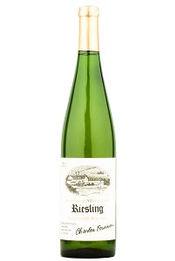|
|
 |

Gold Seal Vineyards, Finger Lakes (New York) Riesling “Charles Fournier” 2012 ($15): Two of the compelling attractions of wine, for me, have to do with time. Older wines enable us to feel that we are experiencing the past. Paradoxically, wine is eternally new, each year bringing new harvests and fresh, new vintages. Occasionally time collapses: We taste a thoroughly new wine that evokes a strong sense of history.
The moment that I saw the label of this Riesling I recognized it, as I would recognize a depiction of Abraham Lincoln. It is the iconic label of an historic winery, bearing the signature of a winemaker who was pivotal in  the development of New York State as a fine wine region. But this nostalgic label carries the vintage 2012 -- now. The wine is a fresh rendition created to honor history. the development of New York State as a fine wine region. But this nostalgic label carries the vintage 2012 -- now. The wine is a fresh rendition created to honor history.
That history is too convoluted to describe in detail. The Gold Seal Winery complex was constructed beginning in 1865, and it became NY State Bonded Winery No. 2; Pleasant Valley Wine Company, founded in 1860, was No. 1. After Prohibition, Gold Seal hired winemaker Charles Fournier away from Champagne Veuve Clicquot. Fournier’s accomplishments included introducing hybrid vines to New York’s vineyards to replace native American varieties, recruiting Dr. Konstantin Frank to pioneer the cultivation of vinifera vines, and grafting native rootstocks to protect the vinifera vines from phylloxera. In 1962, Dr. Frank established his own winery. Starting in 1979, Gold Seal Vineyards became the property of a string of powerful corporate owners, as did Pleasant Valley. In the mid 1990s, the Doyle family took control under the name Pleasant Valley Wine Company. Their old Gold Seal vineyards remain the pride of winemakers who purchase the grapes.
In 2010, Bruce Schneider and Charles Bieler purchased Riesling grapes from the Doyle Vineyard on Seneca Lake for their innovative Gotham Project keg-packaged Riesling, and learned that the site was one of the last vineyards to be planted by Charles Fournier in the early 1970s. They succeeded in gaining the Doyle family’s permission to re-introduce the Gold Seal Vineyards label as a tribute to Charles Fournier’s vision. For this Riesling, the Doyle Vineyard is one of three grape sources.
Apart from having an interesting story, is the wine itself any good? Absolutely! The 2012 Gold Seal Vineyards Riesling is not only a fine Finger Lakes Riesling, but also a fine Riesling, period. It’s a dry Riesling with five grams of residual sugar -- not technically bone dry, but certainly dry in taste. It has vibrant aromas and flavors of citrus peel, peach stones, tart apple and tangerine, along with savory stony and mineral notes. It’s medium-bodied, with crisp acidity and viscous texture that you might describe as oily. The wine boasts real weight and presence and it carries a charge of energy across your mouth.
In addition to this Riesling, Bieler and Schneider have produced, under the Gold Seal Vineyards label, an unoaked Chardonnay ($13) exclusively from the Doyle Vineyard; it is a vibrant, medium-bodied Chardonnay with good concentration of green apple, citrus and stony flavors. The Gold Seal Vineyards/Charles Fournier line will also include a Cabernet Franc ($19) and a Rosé of Cabernet Franc ($13), to be released very soon, and I look forward to tasting them. Production of the Riesling is 1202 cases, and the Chardonnay production is only a third of that.
My mouth and my analytical wine judgment find pleasure in this Riesling and its companion Chardonnay. My spirit finds deep satisfaction.
91 Points
|
 |
|